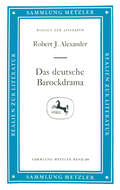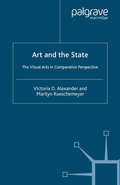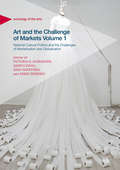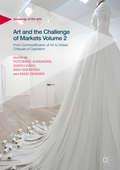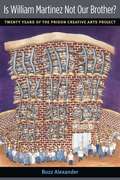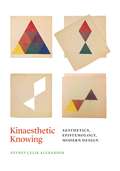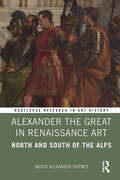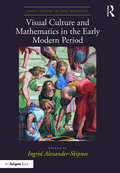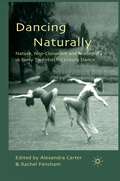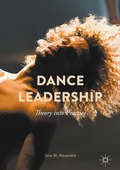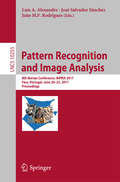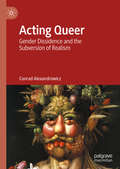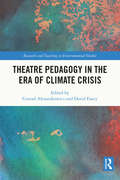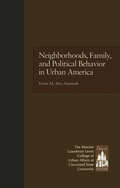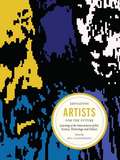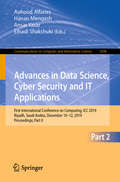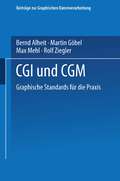- Table View
- List View
Art and the State: The Visual Arts in Comparative Perspective (St Antony's Series)
by V. Alexander M. RueschemeyerThis book examines the impact of states and their policies on visual art. States shape the role of art and artists in society, influence the development of audiences, support artistic work, and even affect the very nature of artistic production. The book contrasts developments in the United States with art policies in Britain and in the social democratic states of Norway and Sweden. In addition, it analyzes revealing transitions - the changes brought about in East Germany after unification and the experiences of artists who left the Soviet Union for the west. The result is a significant contribution to the sociology and the political economy of art.
Art and the Challenge of Markets Volume 1: National Cultural Politics and the Challenges of Marketization and Globalization (Sociology of the Arts)
by Victoria D. Alexander Samuli Hägg Simo Häyrynen Erkki SevänenArt and the Challenge of Markets Volumes 1 & 2 examine the politics of art and culture in light of the profound changes that have taken place in the world order since the 1980s and 1990s. The contributors explore how in these two decades, the neoliberal or market-based model of capitalism started to spread from the economic realm to other areas of society. As a result, many aspects of contemporary Western societies increasingly function in the same way as the private enterprise sector under traditional market capitalism. The first volume of this two-volume collection considers a broad range of national cultural policies from European and North American countries, and examines the strengthening of international and transnational art worlds in music, visual arts, film, and television. The chapters cover cultural policy and political culture in the United States, United Kingdom, Germany, France, Switzerland, the Nordic countries, the Balkans, and Slovenia, and address the extent to which Western nations have shifted from welfare-state to market-based ideologies. Tensions between centres and peripheries in global art worlds are considered, as well as complex interactions between nations and international and transnational art worlds, and regional variations in the audiovisual market. Both volumes provide students and scholars across a range of disciplines with an incisive, comparative overview of the politics of art and culture and national, international and transnational art worlds in contemporary capitalism.
Art and the Challenge of Markets Volume 2: From Commodification of Art to Artistic Critiques of Capitalism (Sociology of the Arts)
by Victoria D. Alexander Samuli Hägg Simo Häyrynen Erkki SevänenArt and the Challenge of Markets Volumes 1 & 2 examine the politics of art and culture in light of the profound changes that have taken place in the world order since the 1980s and 1990s. The contributors explore how in these two decades, the neoliberal or market-based model of capitalism started to spread from the economic realm to other areas of society. As a result, many aspects of contemporary Western societies increasingly function in the same way as the private enterprise sector under traditional market capitalism.This second volume analyses the relationships of art with contemporary capitalist economies and instrumentalist cultural policies, and examines several varieties of capitalist-critical and alternative art forms that exist in today’s art worlds. It also addresses the vexed issues of art controversies and censorship. The chapters cover issues such as the culturalization of the economy, aesthetics and anti-aesthetics, the societal benefits of works of art, art's responsibility to society, "artivism", activist arts as protest and capitalism-critical works, and controversies over nudity in art, as well as considering the marketisation of emerging visual arts worlds in East Asia. The book ends with the a concluding chapter suggesting that even in today's marketized and commercialized environments, art will find a way. Both volumes provide students and scholars across a range of disciplines with an incisive, comparative overview of the politics of art and culture and national, international and transnational art worlds in contemporary capitalism.
Is William Martinez Not Our Brother?: Twenty Years of the Prison Creative Arts Project (The New Public Scholarship)
by William AlexanderPraise for the Prison Creative Arts Project: "I cannot overstate how profoundly my experience with the Prison Creative Arts Project has shaped my life. It began my engagement with prison issues, developed both my passion and my understanding of them, and I continue to draw on both as I seek to contribute to a more rational, humane and just criminal justice system. PCAP prepared me to adapt to any situation, to take risks, to collaborate with people very different from myself in a manner infused with total respect." ---Jesse Jannetta, researcher, Justice Policy Center, the Urban Institute "PCAP provided me with an emotional education that I would not have received otherwise. PCAP continually opens the doors to the stark reality of our criminal justice system as well as our society's ability to right the wrongs of that system and provide justice to millions of men, women, and children . . . PCAP showed me the power I, and the individuals around me, have to make a difference." ---Anne Bowles, Policy and Outreach Associate, Institute for Higher Education Policy "PCAP looks beyond past mistakes and personal shortcomings to find the beauty and creative energies that help to heal the hurts we've done to others. They have not forgotten that we are human too! . . . Their program has given me a way to reach people that I would otherwise never reach. For that, I owe PCAP everything. They are my lifeline that I cling to." ---Bryan Picken, incarcerated artist Prisons are an invisible, but dominant, part of American society: the United States incarcerates more people than any other nation in the world. In Michigan, the number of prisoners rose from 3,000 in 1970 to more than 50,000 by 2008, a shift that Buzz Alexander witnessed firsthand when he came to teach at the University of Michigan. Is William Martinez Not Our Brother? describes the University of Michigan's Prison Creative Arts Project (PCAP), a pioneering program founded in 1990 that provides university courses, a nonprofit organization, and a national network for incarcerated youth and adults in Michigan juvenile facilities and prisons. By giving incarcerated individuals an opportunity to participate in the arts, PCAP enables them to withstand and often overcome the conditions and culture of prison, the policies of an incarcerating state, and the consequences of mass incarceration. Buzz Alexander is Arthur F. Thurnau Professor of English Language and Literature, College of Literature, Science, and the Arts, at the University of Michigan and was Carnegie National Professor of the Year in 2005. Cover image: Overcrowded by Ronald Rohn
Kinaesthetic Knowing: Aesthetics, Epistemology, Modern Design
by Zeynep Çelik AlexanderIs all knowledge the product of thought? Or can the physical interactions of the body with the world produce reliable knowledge? In late-nineteenth-century Europe, scientists, artists, and other intellectuals theorized the latter as a new way of knowing, which Zeynep Çelik Alexander here dubs “kinaesthetic knowing.” In this book, Alexander offers the first major intellectual history of kinaesthetic knowing and its influence on the formation of modern art and architecture and especially modern design education. Focusing in particular on Germany and tracing the story up to the start of World War II, Alexander reveals the tension between intellectual meditation and immediate experience to be at the heart of the modern discourse of aesthetics, playing a major part in the artistic and teaching practices of numerous key figures of the period, including Heinrich Wölfflin, Hermann Obrist, August Endell, László Moholy-Nagy, and many others. Ultimately, she shows, kinaesthetic knowing did not become the foundation of the human sciences, as some of its advocates had hoped, but it did lay the groundwork—at such institutions as the Bauhaus—for modern art and architecture in the twentieth century.
Kinaesthetic Knowing: Aesthetics, Epistemology, Modern Design
by Zeynep Çelik AlexanderIs all knowledge the product of thought? Or can the physical interactions of the body with the world produce reliable knowledge? In late-nineteenth-century Europe, scientists, artists, and other intellectuals theorized the latter as a new way of knowing, which Zeynep Çelik Alexander here dubs “kinaesthetic knowing.” In this book, Alexander offers the first major intellectual history of kinaesthetic knowing and its influence on the formation of modern art and architecture and especially modern design education. Focusing in particular on Germany and tracing the story up to the start of World War II, Alexander reveals the tension between intellectual meditation and immediate experience to be at the heart of the modern discourse of aesthetics, playing a major part in the artistic and teaching practices of numerous key figures of the period, including Heinrich Wölfflin, Hermann Obrist, August Endell, László Moholy-Nagy, and many others. Ultimately, she shows, kinaesthetic knowing did not become the foundation of the human sciences, as some of its advocates had hoped, but it did lay the groundwork—at such institutions as the Bauhaus—for modern art and architecture in the twentieth century.
Kinaesthetic Knowing: Aesthetics, Epistemology, Modern Design
by Zeynep Çelik AlexanderIs all knowledge the product of thought? Or can the physical interactions of the body with the world produce reliable knowledge? In late-nineteenth-century Europe, scientists, artists, and other intellectuals theorized the latter as a new way of knowing, which Zeynep Çelik Alexander here dubs “kinaesthetic knowing.” In this book, Alexander offers the first major intellectual history of kinaesthetic knowing and its influence on the formation of modern art and architecture and especially modern design education. Focusing in particular on Germany and tracing the story up to the start of World War II, Alexander reveals the tension between intellectual meditation and immediate experience to be at the heart of the modern discourse of aesthetics, playing a major part in the artistic and teaching practices of numerous key figures of the period, including Heinrich Wölfflin, Hermann Obrist, August Endell, László Moholy-Nagy, and many others. Ultimately, she shows, kinaesthetic knowing did not become the foundation of the human sciences, as some of its advocates had hoped, but it did lay the groundwork—at such institutions as the Bauhaus—for modern art and architecture in the twentieth century.
Kinaesthetic Knowing: Aesthetics, Epistemology, Modern Design
by Zeynep Çelik AlexanderIs all knowledge the product of thought? Or can the physical interactions of the body with the world produce reliable knowledge? In late-nineteenth-century Europe, scientists, artists, and other intellectuals theorized the latter as a new way of knowing, which Zeynep Çelik Alexander here dubs “kinaesthetic knowing.” In this book, Alexander offers the first major intellectual history of kinaesthetic knowing and its influence on the formation of modern art and architecture and especially modern design education. Focusing in particular on Germany and tracing the story up to the start of World War II, Alexander reveals the tension between intellectual meditation and immediate experience to be at the heart of the modern discourse of aesthetics, playing a major part in the artistic and teaching practices of numerous key figures of the period, including Heinrich Wölfflin, Hermann Obrist, August Endell, László Moholy-Nagy, and many others. Ultimately, she shows, kinaesthetic knowing did not become the foundation of the human sciences, as some of its advocates had hoped, but it did lay the groundwork—at such institutions as the Bauhaus—for modern art and architecture in the twentieth century.
Alexander the Great in Renaissance Art: North and South of the Alps (Routledge Research in Art History)
by Ingrid Alexander-SkipnesThis volume explores the images of Alexander the Great from the fifteenth and sixteenth centuries, how they came about, and why they were so popular.In contrast to the numerous studies on the historical and legendary figure of Alexander, surprisingly few studies have examined, in one volume, the visual representation of the Macedonian king in frescoes, oil paintings, engravings, manuscripts, medals, sculpture, and tapestries during the Renaissance. The book covers a broad geographical area and includes transalpine perspectives. Ingrid Alexander-Skipnes examines the role that humanists played in disseminating the stories about Alexander and explores why Alexander was so popular during the Renaissance. Alexander-Skipnes offers cultural, political, and social perspectives on the Macedonian king and shows how Renaissance artists and patrons viewed Alexander the Great.The book will be of interest to scholars working in art history, Renaissance studies, ancient Greek history, and classics.
Alexander the Great in Renaissance Art: North and South of the Alps (Routledge Research in Art History)
by Ingrid Alexander-SkipnesThis volume explores the images of Alexander the Great from the fifteenth and sixteenth centuries, how they came about, and why they were so popular.In contrast to the numerous studies on the historical and legendary figure of Alexander, surprisingly few studies have examined, in one volume, the visual representation of the Macedonian king in frescoes, oil paintings, engravings, manuscripts, medals, sculpture, and tapestries during the Renaissance. The book covers a broad geographical area and includes transalpine perspectives. Ingrid Alexander-Skipnes examines the role that humanists played in disseminating the stories about Alexander and explores why Alexander was so popular during the Renaissance. Alexander-Skipnes offers cultural, political, and social perspectives on the Macedonian king and shows how Renaissance artists and patrons viewed Alexander the Great.The book will be of interest to scholars working in art history, Renaissance studies, ancient Greek history, and classics.
Visual Culture and Mathematics in the Early Modern Period (Visual Culture in Early Modernity)
by Ingrid Alexander-SkipnesDuring the early modern period there was a natural correspondence between how artists might benefit from the knowledge of mathematics and how mathematicians might explore, through advances in the study of visual culture, new areas of enquiry that would uncover the mysteries of the visible world. This volume makes its contribution by offering new interdisciplinary approaches that not only investigate perspective but also examine how mathematics enriched aesthetic theory and the human mind. The contributors explore the portrayal of mathematical activity and mathematicians as well as their ideas and instruments, how artists displayed their mathematical skills and the choices visual artists made between geometry and arithmetic, as well as Euclid’s impact on drawing, artistic practice and theory. These chapters cover a broad geographical area that includes Italy, Switzerland, Germany, the Netherlands, France and England. The artists, philosophers and mathematicians whose work is discussed include Leon Battista Alberti, Nicholas Cusanus, Marsilio Ficino, Francesco di Giorgio, Leonardo da Vinci and Andrea del Verrocchio, as well as Michelangelo, Galileo, Piero della Francesca, Girard Desargues, William Hogarth, Albrecht Dürer, Luca Pacioli and Raphael.
Visual Culture and Mathematics in the Early Modern Period (Visual Culture in Early Modernity)
by Ingrid Alexander-SkipnesDuring the early modern period there was a natural correspondence between how artists might benefit from the knowledge of mathematics and how mathematicians might explore, through advances in the study of visual culture, new areas of enquiry that would uncover the mysteries of the visible world. This volume makes its contribution by offering new interdisciplinary approaches that not only investigate perspective but also examine how mathematics enriched aesthetic theory and the human mind. The contributors explore the portrayal of mathematical activity and mathematicians as well as their ideas and instruments, how artists displayed their mathematical skills and the choices visual artists made between geometry and arithmetic, as well as Euclid’s impact on drawing, artistic practice and theory. These chapters cover a broad geographical area that includes Italy, Switzerland, Germany, the Netherlands, France and England. The artists, philosophers and mathematicians whose work is discussed include Leon Battista Alberti, Nicholas Cusanus, Marsilio Ficino, Francesco di Giorgio, Leonardo da Vinci and Andrea del Verrocchio, as well as Michelangelo, Galileo, Piero della Francesca, Girard Desargues, William Hogarth, Albrecht Dürer, Luca Pacioli and Raphael.
Dancing Naturally: Nature, Neo-Classicism and Modernity in Early Twentieth-Century Dance
by Alexandra Carter and Rachel FenshamA renewed interest in nature, the ancient Greeks, and the freedom of the body was to transform dance and physical culture in the early twentieth century. The book discusses the creative individuals and developments in science and other art forms that shaped the evolution of modern dance in its international context.
Dance Leadership: Theory Into Practice
by Jane M. AlexandreThis “what is”—rather than “how to”— volume proposes a theoretical framework for understanding dance leadership for dancers, leaders, and students of both domains, illustrated by portraits of leaders in action in India, South Africa, UK, US, Brazil and Canada. What is dance leadership? Who practices it, in what setting, and why? Through performance, choreography, teaching, writing, organizing and directing, the dance leaders portrayed herein instigate change and forward movement. Illustrating all that is unique about leading in dance, and by extension the other arts, readers can engage with such wide-ranging issues as: Does the practice of leading require followers? How does one individual’s dance movement act on others in a group? What does ‘social engagement’ mean for artists? Is the pursuit of art and culture a human right?
Pattern Recognition and Image Analysis: 8th Iberian Conference, IbPRIA 2017, Faro, Portugal, June 20-23, 2017, Proceedings (Lecture Notes in Computer Science #10255)
by Luís A. Alexandre José Salvador Sánchez João M. RodriguesThis book constitutes the refereed proceedings of the 8th Iberian Conference on Pattern Recognition and Image Analysis, IbPRIA 2017, held in Faro, Portugal, in June 2017. The 60 regular papers presented in this volume were carefully reviewed and selected from 86 submissions. They are organized in topical sections named: Pattern Recognition and Machine Learning; Computer Vision; Image and Signal Processing; Medical Image; and Applications.
Acting Queer: Gender Dissidence and the Subversion of Realism
by Conrad AlexandrowiczThis book is situated at the intersection of queer/gender studies and theories of acting pedagogy and performance. It explores the social and cultural matrix in which matters of gender are negotiated, including that of post-secondary theatre and drama education. It identifies the predicament of gender dissident actors who must contend with the widespread enforcement of realist paradigms within the academy, and proposes a re-imagining of the way drama/theatre/performance are practised in order to serve more fairly and effectively the needs of queer actors in training. This is located within a larger project of critique in reference to the art form as a whole. The book stimulates discussion among practitioners and scholars on matters concerning various kinds of diversity: of gender expression, of approaches to the teaching of acting, and to the way the art form may be imagined and executed in the early years of the 21st Century, in particular in the face of the climate crisis. But it is also an aid to practitioners who are seeking new theoretical and practical approaches to dealing with gender diversity in acting pedagogy.
Theatre Pedagogy in the Era of Climate Crisis (Research and Teaching in Environmental Studies)
by Conrad Alexandrowicz David FancyThis volume explores whether theatre pedagogy can and should be transformed in response to the global climate crisis. Conrad Alexandrowicz and David Fancy present an innovative re-imagining of the ways in which the art of theatre, and the pedagogical apparatus that feeds and supports it, might contribute to global efforts in climate protest and action. Comprised of contributions from a broad range of scholars and practitioners, the volume explores whether an adherence to aesthetic values can be preserved when art is instrumentalized as protest and considers theatre as a tool to be employed by the School Strike for Climate movement. Considering perspectives from areas including performance, directing, production, design, theory and history, this book will prompt vital discussions which could transform curricular design and implementation in the light of the climate crisis. Theatre Pedagogy in the Era of Climate Crisis will be of great interest to students, scholars and practitioners of climate change and theatre and performance studies.
Theatre Pedagogy in the Era of Climate Crisis (Research and Teaching in Environmental Studies)
by Conrad Alexandrowicz David FancyThis volume explores whether theatre pedagogy can and should be transformed in response to the global climate crisis. Conrad Alexandrowicz and David Fancy present an innovative re-imagining of the ways in which the art of theatre, and the pedagogical apparatus that feeds and supports it, might contribute to global efforts in climate protest and action. Comprised of contributions from a broad range of scholars and practitioners, the volume explores whether an adherence to aesthetic values can be preserved when art is instrumentalized as protest and considers theatre as a tool to be employed by the School Strike for Climate movement. Considering perspectives from areas including performance, directing, production, design, theory and history, this book will prompt vital discussions which could transform curricular design and implementation in the light of the climate crisis. Theatre Pedagogy in the Era of Climate Crisis will be of great interest to students, scholars and practitioners of climate change and theatre and performance studies.
Neighborhoods, Family, and Political Behavior in Urban America: Political Behavior & Orientations (Contemporary Urban Affairs)
by Yvette Alex-AssensohUndergirded by a multidisciplinary framework of political science, geography, and sociology, this book examines hte manner in which neighborhood economic resources and family structure shape individual political behavior among white and black citizens in urban America.
Neighborhoods, Family, and Political Behavior in Urban America: Political Behavior & Orientations (Contemporary Urban Affairs)
by Yvette Alex-AssensohUndergirded by a multidisciplinary framework of political science, geography, and sociology, this book examines hte manner in which neighborhood economic resources and family structure shape individual political behavior among white and black citizens in urban America.
Educating Artists For The Future: Learning At The Intersections Of Art, Science, Technology, And Culture (PDF)
by Mel Alexenberg"Educating Artists in a Digital Age" offers ground-breaking guidelines for higher art education, presenting a focus on developing digital and cultural systems and the way that contemporary education must accept and reflect these changes. This collection, the first book concerned with educating artists themselves for the post-digital age, presents dynamic new teaching strategies from a culturally diverse range of artists, researchers and teachers, focusing on student-concentrated, interactive and relevant learning.The book charts the dissolving boundaries between science, technology, culture and art, investigating and redefining art and higher art education.It is the only book published on the educating new media artists for a post-digital future. It provides a polycultural look at higher education in art and design. It also provides exemplary models for education in all fields of human endeavour in a conceptual age which demands creative people skilled in integrating high tech and high touch abilities.
Educating Artists For The Future: Learning At The Intersections Of Art, Science, Technology, And Culture
by Mel Alexenberg"Educating Artists in a Digital Age" offers ground-breaking guidelines for higher art education, presenting a focus on developing digital and cultural systems and the way that contemporary education must accept and reflect these changes. This collection, the first book concerned with educating artists themselves for the post-digital age, presents dynamic new teaching strategies from a culturally diverse range of artists, researchers and teachers, focusing on student-concentrated, interactive and relevant learning.The book charts the dissolving boundaries between science, technology, culture and art, investigating and redefining art and higher art education.It is the only book published on the educating new media artists for a post-digital future. It provides a polycultural look at higher education in art and design. It also provides exemplary models for education in all fields of human endeavour in a conceptual age which demands creative people skilled in integrating high tech and high touch abilities.
Advances in Data Science, Cyber Security and IT Applications: First International Conference on Computing, ICC 2019, Riyadh, Saudi Arabia, December 10–12, 2019, Proceedings, Part II (Communications in Computer and Information Science #1098)
by Auhood Alfaries Hanan Mengash Ansar Yasar Elhadi ShakshukiThis book constitutes the refereed proceedings of the First International Conference on Intelligent Cloud Computing, ICC 2019, held in Riyadh, Saudi Arabia, in December 2019. The two-volume set presents 53 full papers, which were carefully reviewed and selected from 174 submissions. The papers are organized in topical sections on Cyber Security; Data Science; Information Technology and Applications; Network and IoT.
CGI und CGM: Graphische Standards für die Praxis (Beiträge zur Graphischen Datenverarbeitung)
by Bernd Alheit Martin Göbel Max Mehl Rolf ZieglerDieses Buch behandelt zwei internationale Standards der Graphischen Datenverarbeitung (Computer Graphics). CGI (Computer Graphics Interface) definiert eine Schnittstelle zu interaktiven graphischen Ausgabegeräten. CGM (Computer Graphics Metafile) beschreibt die Schnittstelle, die zur Bilddefinition auf Speichermedien oder zur Übertragung graphischer Daten zwischen verschiedenen Graphikpaketen benutzt wird. Das Buch gibt einen umfassenden Einblick in die Konzepte und Methoden dieser beiden Geräteschnittstellen. Die Einordnung in die Vielzahl weiterer Standards der Graphischen Datenverarbeitung wurde besonders berücksichtigt. Dieses Buch ist die erste umfangreiche Beschreibung dieses Themas in deutscher Sprache. Da alle graphischen Standards und die Sekundärliteratur nur in englischer Sprache vorliegen, dient es dazu, dem Leser einen vereinfachten Zugang zu den Themenbereichen zu geben. Das Ziel dieses Buches ist, dem Neuling im Bereich der graphischen Standards einen umfassenden und dennoch kompakten Einstieg zu vermitteln. Erfahrenere Leser erhalten detaillierte Informationen. Implementierer dieser Standards können die über die Beschreibung der Standards hinausgehenden Bemerkungen nutzen.
